Horton IX V1
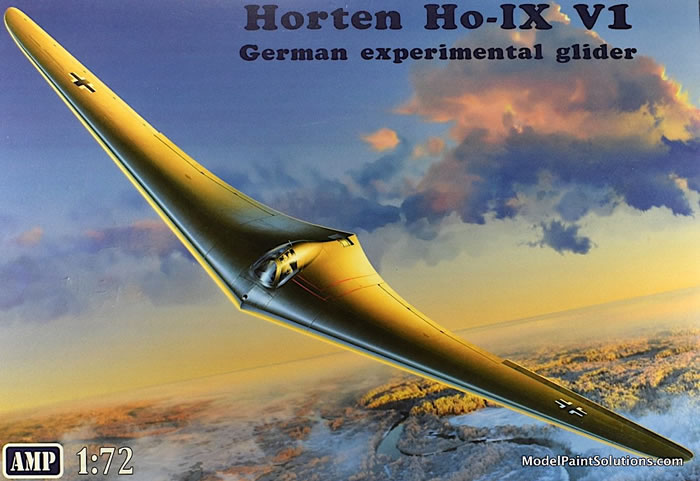
AMP, 1/72 scale
S
u m m a r y : |
Description and Item No.: |
AMP Kit No.AMP72007 - Horton IX V1 |
Contents and Media: |
44 parts in grey plastic, 2 clear parts, and one decal sheet with markings for one airframe. |
Price: |
£23.00 Plus Shipping from Hannants |
Scale: |
1/72 |
Review Type: |
First Look |
Advantages: |
Simple kit, interesting subject that scores high marks on the novelty scale. |
Disadvantages: |
Extra work will be required for clean-up and possibly re-finishing some surfaces. |
Recommendation: |
This is a neat kit that scores high on the novelty scale but will require extra work and attention to make the most with what’s in the box. |
Reviewed by John Miller

Background:
In the early 1930s, the Horton Brothers had become interested in the flying wing design as a method of improving the performance of gliders. The German government was funding glider clubs at the time because production of military and even motorized aircraft was forbidden by the Treaty of Versailles after WWI. The flying wing layout removed the need for a tail and associated control surfaces and theoretically offered the lowest possible weight, using wings that were relatively short and sturdy, and without the added drag of the fuselage.
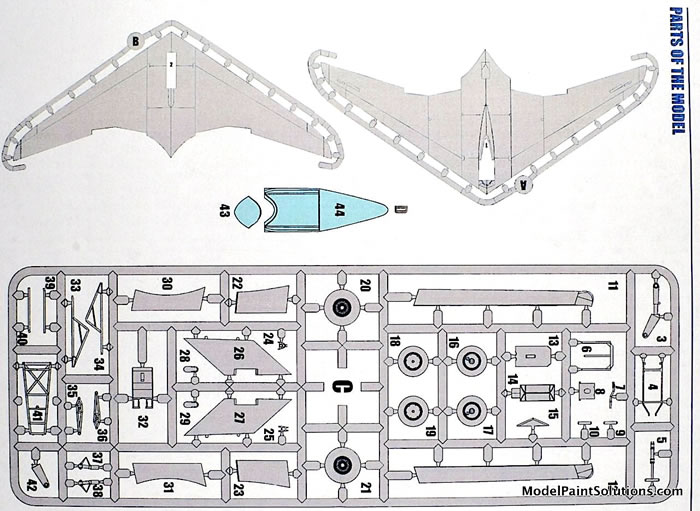
With the backing of Herman Göring and the German government, the Horton brothers, working in conjunction with Gothaer Waggonfabrik, built multiple flying prototypes prior to production of the Horton H.IX. The H.IX was of mixed construction with the center pod made from welded steel tubing and wing spars built from wood. The wings were made from two thin, plywood panels glued together with a charcoal and sawdust mixture. The wing had a single main spar, penetrated by the jet engine inlets, and a secondary spar used for attaching the elevons. The aircraft utilized retractable tricycle landing gear, with the nose gear on the first two prototypes sourced from a He-177’s tailwheel system. A drogue parachute slowed the aircraft upon landing. Control was achieved with elevons and spoilers.
The Ho-IX V1:
The first prototype, the H.IX V1 and the subject of this AMP kit, was an unpowered glider with fixed tricycle landing gear that flew on 1 March 1944. Flight results were very favorable hence the design was taken from the Horten brothers and given to Gothaer Waggonfabrik. The Gotha team made changes by adding a simple ejection seat and dramatically changing the undercarriage to enable a higher gross weight.
The H.IX V1 was followed in December 1944 by the Junkers Jumo-004-powered second prototype H.IX V2.The first flight of the H.IX V2 was made at Oranienburg on 2 February 1945. All subsequent test flights and development were done by Gothaer Waggonfabrik.
At first glance, this kit is clearly a limited production model.
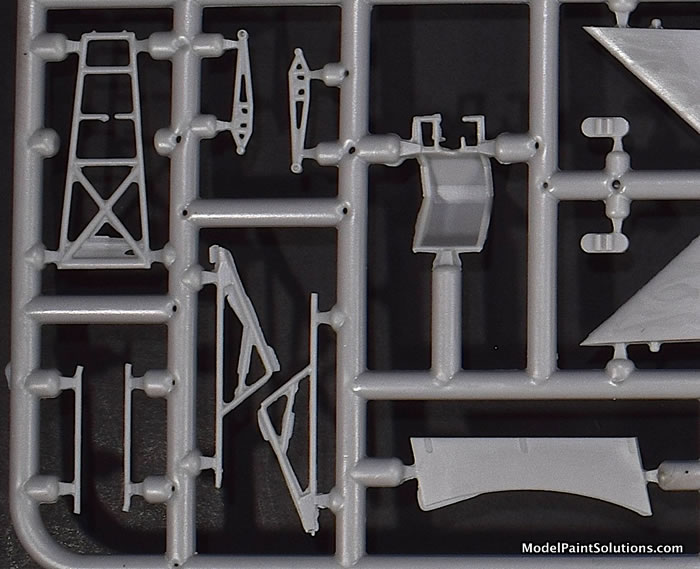
A fair amount of time will be required for parts clean-up and prep as well as time for filling and re-finishing some of the wing surfaces that are marred with imperfections and molding marks.
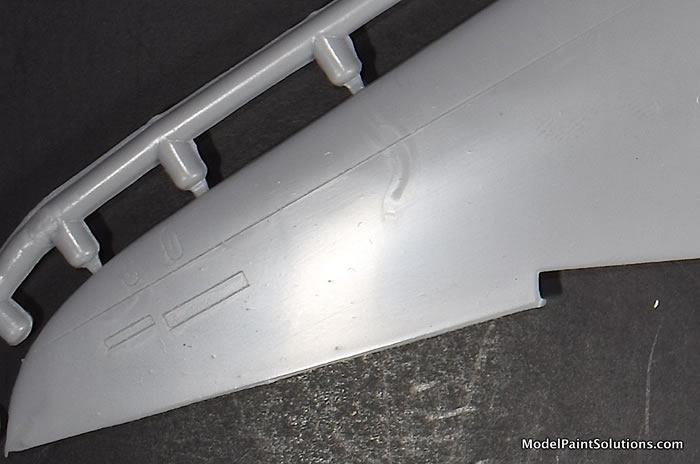
That said, the engineering is straightforward, the layout of upper and lower fuselage halves greatly simplifies assembly, and with only 46 parts total, this looks to be relatively easy build; extra clean-up work aside.
Assembly begins with a steel-tube frame that surrounds the cockpit and a nicely molded “ejection” seat, complete with integral stirrups or feat supports. A control stick (part C7) is provided although its placement is not shown in the instructions. No PE belts are provided.
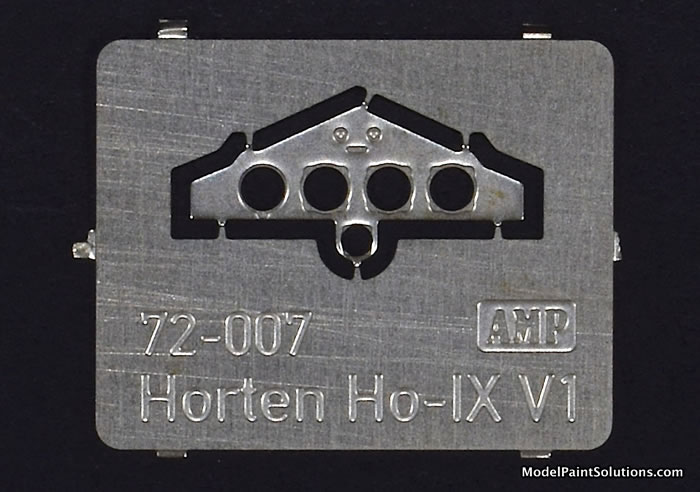
The assembled cockpit and PE instrument panel (with decal instrument faces) fit into the upper fuselage halve followed by the break parachute housing, one-piece inboard and outboard spoilers, and elevons.
Next up is the large nose gear comprised of 12 parts including a halved wheel/tire. Once assembled, the nose gear fits into the lower fuselage halve. The upper and lower fuselage halves are then assembled thereby completing the majority of the build.
The main, fixed gear, comprised of 8 parts including halved tires/wheels, is assembled next followed by the two part canopy, which can be posed open or closed.

The canopy parts are sufficiently clear but have a slight distortion that will require buffing prior to use.
Markings
The decals, printed by AMP, have good color density and registration.

Markings are provided for one airframe, V1 prototype. The instructions suggest Humbrol #60 for the uppers and Humbrol #25 for the lowers. However, a quick search with the google-machine shows Humbrol 60 to be scarlet red and #25 to be a rather dark blue. I’m going to stick my neck out and suggest these are typos. A quick check of my references suggests uppers of RLM 82 or similar with lowers of RLM 76 would be closer to the mark. Be sure to check your own references.
This is a model that most assuredly scores high on the novelty scale. It’s a simple kit with few parts that should build into a nice looking model. To get the most out of the kit however, extra work will be required to deal with surface imperfections and possibly re-scribe details that are a bit soft. Likewise, a basic cockpit is provided but some extra detailing in this area would add greatly to the completed model. Recommended!
Now go paint something!
—John
For more on this review visit Modelpaintsolutions.com.
https://modelpaintsol.com/reviews/amp-72-horton-ix-v1-72007
Review kit provided by my retirement fund, again.
Text and Images Copyright © 2021 by Model Paint Solutions
Page Created 9 July, 2021
Last updated
9 July, 2021
Back to HyperScale Main Page
Back to Reviews Page
|
Home
| What's New |
Features |
Gallery |
Reviews |
Reference |
Forum |
Search